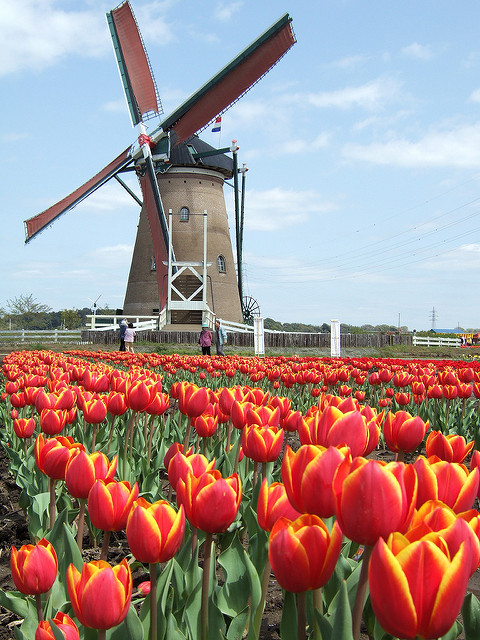
Wind Energy: Back to the Future
Global warming concerns have launched a renewable electricity-generation boom with sleek wind-turbine farms on land and at sea playing a leading role. Yet capturing wind energy using windmills is an ancient science that pre-dates the use of electricity. The invention of the windmill is variously attributed to the Babylonians (circa 1700BC) and the Persians (circa 600-900AD); either way it is still an ancient machine.
 Dutch Windmill in JapanLicense: CC BY-SA 2.0, Hisakuni Fujimoto
Dutch Windmill in JapanLicense: CC BY-SA 2.0, Hisakuni Fujimoto
Prior to the Industrial Revolution (circa 1760-1830) windmills were a primary power source for a host of activities that supported vital food production. They drove pumps to extract water from wells for drinking and irrigating arid lands to make them fertile. They also provided the motive force to grind cereals such as wheat to form flour for bread. From the 12th century onwards in North Western Europe windmill design converged on the familiar multi-blade (usually 4) rotor mounted on a horizontal axis, rotating turret, and tapered tower body. Their utility was extended to drive sawmills and threshers. Windmills and waterwheels were the undisputed kings of power generation. Their virtue of generating no greenhouse gases that cause global warming was of no concern to anyone, but change was in the air.
The Industrial Revolution triggered our dependence on greenhouse gas emitting fossil fuels, starting with coal to power steam engines and extending to oil to power internal combustion engines. Thus began the demise of the renewable power derived from windmills and waterwheels. The intermittent power provided by windmills was a nuisance that the 'always on' steam engine didn't suffer from. So wind power lost its hold on power generation, with steam engines replacing sails on boats and pumps on land. Ultimately the steam engine too would fall from favor, replaced by the internal combustion engine, steam turbine and gas turbine. The distribution of power using electricity solidified coal as a primary fuel for electricity generation. Thus fossil fueled power generation became, and still is, king, only briefly interrupted by the young pretender – nuclear fission power generation.
Rural windmills (or wind-pumps) for pumping water from wells had a brief spell of popularity during the settling of Australia and America. However, electric pumps proved more flexible and were installed as soon as the electricity distribution network reached the remote outposts of these nations. There are still a few instances where wind-pumps are in use today where electricity is unavailable or as part of working museums.
In this enlightened age we are now well aware of greenhouse gases, such as carbon dioxide, causing global warming and thus there is now increasingly a cost associated with using fossil fuels. Renewable energy supplies using wind and water are being pursued with new vigor, especially in light of new materials and methods of construction. Wind turbines are once again a viable source of power generation – it's great to have you back!
- Richard Smith's blog
- Login to post comments
Select Language
Recent blog posts
- CFD Simulates Distant Past
- Background on the Caedium v6.0 Release
- Long-Necked Dinosaurs Succumb To CFD
- CFD Provides Insight Into Mystery Fossils
- Wind Turbine Design According to Insects
- Runners Discover Drafting
- Wind Tunnel and CFD Reveal Best Cycling Tuck
- Active Aerodynamics on the Lamborghini Huracán Performante
- Fluidic Logic
- Stonehenge Vortex Revealed as April Fools' Day Distortion Field

